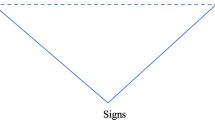Abstract
In this article, we explore questions related to the meaning and nature of time in schooling environments. Cultural, historical and ecological images inform our thinking, using concepts from postmodern perspectives such as semiotics and critical pedagogy. We begin by reviewing the historical development of conceptions of time and describe what is meant by framing our research and thinking in a postmodern vision of time. We examine ideas about other potential meanings of time using semiotic and critical pedagogical interpretations. As the research and recommendations are of value to professional educators and policy makers, we discuss the value of nurturing intellectual relationships, the value of collaboration, and the importance of developing new ways to give voice to teachers to allow them to articulate their views about what is most meaningful and significant in the organization of learning environments.
Similar content being viewed by others
REFERENCES
Apple, M. & Beane, J.A. (1995). Democratic schools. Alexandria, VA: Association for Supervision and Curriculum Development.
Bastedo, J. (1994). Shield country: life and times of the oldest piece of the planet. Calgary, Canada: Arctic Institute of University of Calgary.
Berman, M. (1984). The re-enchantment of the world. Ithaca, NY: Cornell University Press.
Biklen, S.K. (1995). School work: gender and the cultural construction of teaching. New York: Teachers College Press.
Boorstin, D.J. (1983). The discoverers: a history of man's search to know his world and himself. New York: Random House.
Cameron, J. & Bryan, M. (1992). The artist's way: a spiritual path to higher creativity. New York: Putnam's Sons.
Cousins, N. (1975, March 26). Editorial. Saturday Review, p. 6.
Covey, S.R., Merrill, A. & Merrill, R. (1994). First things first: to live, to love, to learn, to leave a legacy. Toronto, Canada: Simon and Schuster.
Danesi, M. (1994). Messages and meanings. Toronto, Canada: Canadian Scholars Press.
Eliade, M. (1971). Myth of the eternal return. (W. Trask, Trans.). Princeton, NJ: Princeton University Press.
Elkind, D. (1981). The hurried child: growing up too fast too soon. Don Mills, Canada: Addison Wesley.
Fien, J. (1993). Education for the environment. Geelong, Australia: Deakin University Press.
Flanagan, D. (1988). Flanagan's version: a spectator's guide to science on the eve of the 21st Century. New York: Random House.
Foltz, B.V. (1995). Inhabiting the earth: Heidegger, environmental ethics and the metaphysics of nature. New York: Humanities Press.
Frank, A.G. (1995). The wounded storyteller. Chicago, IL: The University of Chicago Press.
Galeano, E. (1989). The book of embraces. New York: Norton.
Gandhi, M.K. (1982). All men are brothers: autobiographical reflections. New York: Continuum Publishing Corporation.
Giroux, H. (1994). Slacking off: border youth and postmodern education. Journal of Advanced Composition, 14, 347–366.
Gough, N. (1987). Learning with environments: towards an ecological paradigm for education. In I. Robottom (Ed.), Environmental education practice and possibility (pp. 49—67). Geelong, Australia: Deakin University Press.
Krell, D.F. (Ed.). (1993). Martin Heidegger – Basic writings: from being and time (1927) to the task of thinking (1964). San Francisco, CA: Harper.
Lakoff, G. & Johnson, M. (1980). Metaphors we live by. Chicago, IL: University of Chicago Press.
Macy, J. (1991). World as lover, world as self. Berkeley, CA: Parallax Press.
McLaren, P. (1991). Critical pedagogy: constructing an arch of social dreaming and a doorway to hope. Journal of Education, 173(1), 9–34.
Mohanty, C.T. (1994). On race and voice: challenges for liberal education in the 1990's. In H. Giroux & P. McLaren (Eds.), Between borders: pedagogy and the politics of cultural studies (pp. 146–166). New York: Routledge.
Oelschlaeger, M. (1991). The idea of wilderness. New Haven, CT: Yale University Press.
Purpel, D. (1993). Holistic education in a prophetic voice. In R. Miller (Ed.), The renewal of meaning in education: responses to the cultural and ecological crisis of our times (pp. 68–91). Brandon, VT: Holistic Education Press.
Richards, L. (1997). Deep love: inside-outside ecology and implications for pedagogy, The University of Calgary, Calgary, Canada, unpublished Master of Education final paper.
Shapiro, B. (1998). Reading the furniture: the semiotic interpretation of science learning environments. In B.J. Fraser & K.G. Tobin (Eds.), International handbook of science education (pp. 609–621). Dordrecht, The Netherlands: Kluwer.
Shapiro, B. & Kirby, D. (1997, March). A semiotic interpretive study of text forms in elementary school science learning culture. Paper presented at the annual meeting of the American Educational Research Association, Chicago, IL.
Shapiro, B. & Kirby, D. (1998). An approach to consider the semiotic messages of school science learning culture. Journal of Science Teacher Education, 9, 221–240.
Slattery, P. (1995). A postmodern vision of time and learning: a response to the national education commission report 'Prisoners of Time'. Harvard Educational Review, 65, 612–633.
U.S. Government Printing Office. (1994). Prisoners of time: report of the National Education Commission on Time and Learning. Washington, DC: U.S. Department of Education Press.
Whitehead, A.N. (1960). Process and reality: an essay in cosmology. NewYork: Macmillan.
Worth, S. (1981). Visual communication. In L. Gross (Ed.), Studying visual communication (pp. 76–92). Philadelphia, PA: University of Philadelphia Press.
Author information
Authors and Affiliations
Rights and permissions
About this article
Cite this article
Shapiro, B., Richards, L., Ross, N. et al. Time and the Environments of Schooling. Learning Environments Research 2, 1–19 (1999). https://doi.org/10.1023/A:1009991421940
Issue Date:
DOI: https://doi.org/10.1023/A:1009991421940




